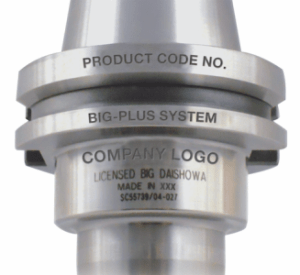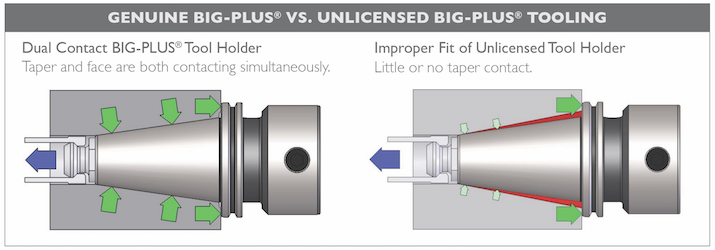¿Es BIG-PLUS un estándar internacional?
Atención al comprador: este sistema no ha sido estandarizado por ningún organismo regulador. Si compra herramientas de doble contacto baratas después de que un proveedor le haya dicho que funcionarán igual de bien que las originales por la mitad de precio, corre el riesgo de obtener un rendimiento insatisfactorio y/o de dañar husillos muy costosos. He aquí por qué.
Cada vez más, recibimos esta pregunta bastante simple de talleres que desean comprar herramientas de doble contacto BIG-PLUS de fuentes distintas a nosotros. Uno podría pensar que este debería ser el caso, dado que más de 100 de los principales fabricantes de máquinas herramienta del mundo han adoptado el sistema de husillo BIG-PLUS como su propio estándar. La respuesta veraz para cualquiera que pregunte es que este sistema no ha sido estandarizado por ningún organismo regulador como ISO, DIN, JIS o ASME.
BIG Daishowa, el desarrollador original de este sistema y una de las principales razones por las que ha sido tan ampliamente aceptado en todo el mundo, aún posee toda la información propietaria y, más importante, los calibradores maestros principales utilizados para reproducir husillos y herramientas. El acceso a esta información y calibración está bien protegido por BIG y solo se proporciona a aquellas empresas que adquieren un acuerdo de licencia, principalmente para proteger la integridad del sistema, que utiliza tolerancias muy estrechas para funcionar en su nivel de rendimiento diseñado.
La popularidad de BIG-PLUS ha aumentado durante los últimos diez años, ya que muchos talleres han probado el sistema y han comprobado por sí mismos los enormes beneficios en rendimiento y precisión en comparación con los sistemas de contacto de cono estandarizados, como CAT o BT. Otros sistemas de doble contacto, como HSK, también han visto un aumento en popularidad por razones similares, aunque quizás no con todos los mismos beneficios que BIG-PLUS. Desafortunadamente, toda esta mayor popularidad y demanda ha venido acompañada de una ola de copias no licenciadas en el mercado que ofrecen todo tipo de promesas y precios nunca antes vistos.
Atención al comprador
No puedo culpar a un taller por comprar herramientas de doble contacto baratas después de que su proveedor le haya dicho que funcionarán igual de bien que las originales por la mitad del precio. Al fin y al cabo, la naturaleza humana busca la mejor oferta al mejor precio; ese tipo de trato es el capitalismo en su máxima expresión. Como consumidores, todos nos enfrentamos cada día a decisiones sobre la compra de productos similares que realizan funciones parecidas, ofrecidos por una amplia gama de proveedores y precios. Personalmente, suelo decidir comprar barato solo cuando sé que el producto se usará una vez y luego se desechará. En todas las demás compras, pienso a largo plazo y estoy dispuesto a pagar precios más altos. Al final del día, quiero tener la confianza de haber tomado la decisión correcta a largo plazo, y estoy dispuesto a pagar más por mi tranquilidad.
Los calibradores maestros para herramientas son bastante comunes. Generalmente, todos son rastreables a un calibrador maestro conocido que sirve para comparar la precisión de la conicidad en la producción de portaherramientas, como CAT o BT. Los sistemas de doble contacto ISO, como HSK, dependen del uso de un calibrador maestro principal del cual se producen todos los demás calibradores maestros, garantizando así que todos los portaherramientas HSK sean iguales en cualquier parte del mundo. Nuestra empresa decidió averiguar cómo se comparaban los principales proveedores mundiales de portaherramientas HSK con las tolerancias del estándar ISO. Tras adquirir más de 30 herramientas cónicas HSK-A63 de nuestros competidores de todo el mundo y realizar una inspección de calidad detallada del cono, descubrimos que el 50 por ciento de las muestras no estaban dentro de tolerancia.
Quizás los desarrolladores de HSK fueron demasiado estrictos con los límites funcionales y las tolerancias del estándar, dado que el 50 por ciento de las herramientas en uso hoy están fuera de tolerancia. En mi opinión, esto podría ser posible debido a la sección transversal muy delgada de los conos HSK, que permite que los portaherramientas se expandan elásticamente más de lo previsto. Por el contrario, tenemos a BIG-PLUS, que depende de la deformación elástica del husillo, no del portaherramientas, lo que requiere un control de tolerancias mucho más estricto, incluso en comparación con HSK. Esto significa que cualquiera que esté buscando herramientas de “doble contacto BIG-PLUS” también debería considerar esta sencilla afirmación: solo un proveedor con licencia de BIG-PLUS posee calibradores maestros rastreables a los calibradores maestros principales de BIG y las dimensiones y tolerancias necesarias para hacerlo correctamente. Todos los demás están adivinando y utilizando un portaherramientas BIG-PLUS de muestra como su propio calibrador maestro, una práctica que cualquier experto en calidad desaconsejará.
¿Cuáles son las consecuencias de una elección mal investigada en herramientas BIG-PLUS? A menos que todas las herramientas estén marcadas con “BIG-PLUS Spindle System-License BIG DAISHOWA SEIKI”, el uso de herramientas que no sean fabricadas por BIG Daishowa o sus licenciatarios puede resultar en un rendimiento insatisfactorio y/o en daños a husillos muy costosos. Las condiciones que producen dicho rendimiento insatisfactorio incluyen:
- La distancia entre la cara de la brida y el diámetro de la línea de calibración es mayor que la especificación: se produce poco o ningún contacto en la cara; los portaherramientas solo proporcionan contacto cónico y no aprovechan los beneficios de BIG-PLUS.
- La distancia entre la cara de la brida y el diámetro de la línea de calibración es menor que la especificación: solo hay contacto en la cara; los portaherramientas “flotan” en el cono del husillo sin ubicación radial positiva. Se produce un gran descentramiento de la fresa y corrosión por fricción inmediata en la cara del husillo. Se producirán daños graves en el husillo.
- El diámetro de la línea de calibración es menor que la especificación; solo hay contacto en la cara con poco o ningún contacto cónico. Pueden ocurrir daños graves en el husillo.
- El diámetro de la línea de calibración es mayor que la especificación; solo hay contacto cónico y no se obtienen los beneficios de BIG-PLUS.
BIG Daishowa fabrica y distribuye herramientas BIG-PLUS originales con licencia. Para obtener una lista completa de todas las empresas licenciadas de husillos y portaherramientas autorizadas para la producción de BIG-PLUS, contáctenos y recuerde: no acepte sustitutos.
¿Te pareció interesante o útil? Haznos saber tu opinión agregando tus comentarios o preguntas a continuación.







Añadir nuevo comentario